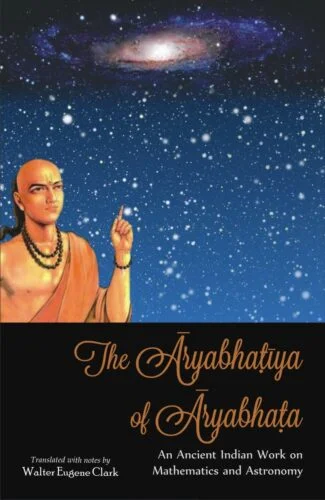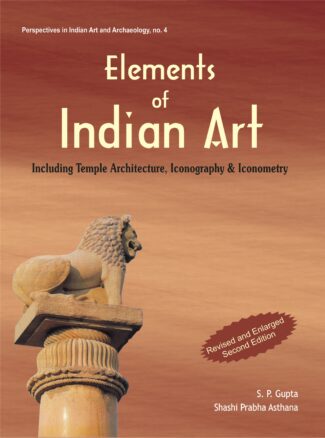

The Aryabhatiya of A...
The Aryabhatiya of Aryabhata
An Ancient Indian Work on Mathematics and Astronomy by: Walter Eugene ClarkThis book introduces Aryabhata and the Aryabhatiya to the new generations through an authentic English translation. It discusses Aryabhata as an innovator and the findings of Aryabhata on dashagitika, ganitapada, kalakriya and gola in great details, endorsing it as quite a genuine work.
Original price was: ₹300.00.₹270.00Current price is: ₹270.00.
ISBN: 9788124608159
Year Of Publication: 2017
Edition: 1st Edition
Pages : xxvii, 107p.
Bibliographic Details : Appendix, Index
Language : English
Binding : Paperback
Publisher: D.K. Printworld Pvt. Ltd.
Size: 22
Weight: 250
The Aryabhatiya of Aryabhata is of great work in the annals of the history of Indian mathematics and astronomy. This volume is expected to give a complete translation (with notes) of the Aryabhatiya with references to some of the most important parallel passages. It is a brief descriptive work intended to supplement matters and processes which are generally known and agreed upon to give only the most distinctive features of Aryabhatas own system. Many common places and many simple processes are taken for granted.
The book vividly addresses topics such as dashagitika, ganitapada, kalakriya and gola in much details. Withstanding many a criticism from people like Brahmagupta on the theories of Aryabhata, this volume through the introductory chapter contends that the Aryabhatiya, on the whole, is quite genuine. It presents Aryabhata as an innovator, thus his difference from Smriti or tradition in his approach to many astronomical matters is fully justified. It also discusses a serious internal discrepancy in the Aryabhatiya about the stationary and revolutionary nature of earth.
This book helps in introducing Aryabhata and the quintessential of Aryabhatiya to the mathematicians and astronomers of the new generations, for whom the original language Sanskrit and the old processes might be unknown.
Preface
List of Abbreviations
I. Dashagitika or the Ten Giti Stanzas
A. Invocation
B. System of Expressing Numbers by Letters of Alphabet
1. Revolutions of Sun, Moon, Earth, and Planets in a Yuga
2. Revolutions of Apsis of Moon, Conjunctions of Planets, and Node of Moon in a yuga; Time and Place from Which Revolutions Are to Be Calculated
3. Number of Manus in a Kalpa; Number of Yugas in Period of a Manu; Part of Kalpa Elapsed up to Bharata Battle
4. Divisions of Circle; Circumference of Sky and Orbits of Planets in Yojanas; Earth Moves One Kala in a Prana; Orbit of Sun One-sixtieth that of Asterisms
5. Length of Yojana; Diameters of Earth, Sun, Moon, Meru, and Planets; Number of Years in a Yuga
6. Greatest Declination of Ecliptic; Greatest Deviation of Moon and Planets from Ecliptic;
Measure of a nri
7. Positions of Ascending Nodes of Planets, and of Apsides of Sun and Planets
8-9. Dimensions of Epicycles of Apsides and Conjunctions of Planets; Circumference
of Earth-Wind
10. Table of Sine-Differences
C. Colophon
II. Ganitapada or Mathematics
1. Invocation
2. Names and Values of Classes of Numbers
Increasing by Powers of Ten
3. Definitions of Square (Varga) and Cube (Ghana)
4. Square Root
5. Cube Root
6. Area of Triangle; Volume of Pyramid
7. Area of Circle; Volume of Sphere
8. Area of Trapezium; Length of Perpendiculars from Intersection of Diagonals to Parallel Sides
9. Area of Any Plane Figure; Chord of One-sixth Circumference Equal to Radius
10. Relation of Circumference of Circle to Diameter
11. Method of Constructing Sines by Forming Triangles and Quadrilaterals in Quadrant
of Circle
12. Calculation of Table of Sine-Differences from First One
13. Construction of Circles, Triangles, and Quadrilaterals; Determination of Horizontal
and Perpendicular
14. Radius of Khavritta (or Svavritta); Hypotenuse of Right-Angle Triangle Formed by Gnomon and Shadow
15-16. Shadow Problems
17. Hypotenuse of Right-Angle Triangle; Relation of Half-Chord to Segments of Diameter Which Bisects Chord
18. Calculation of Sampatasharas When Two Circles Intersect
19-20. Arithmetical Progression
21. Sum of Series Formed by Taking Sums of Terms of an Arithmetical Progression
22. Sums of Series Formed by Taking Squares and Cubes of Terms of an Arithmetical Progression
23. Product of Two Factors Half the Difference between Square of Their Sum and Sum of
Their Squares
24. To Find Two Factors When Product and Difference Are Known
25. Interest
26. Rule of Three (Proportion)
27. Fractions
28. Inverse Method
29. To Find Sum of Several Numbers When Results Obtained by Subtracting Each
Number from Their Sum Are Known
30. To Find Value of Unknown When Two Equal Quantities Consist of Knowns and Similar Unknowns
31. To Calculate Their Past and Future Conjunctions from Distance between
Two Planets
32-33. Indeterminate Equations of First Degree (kuttaka)
III. Kalakriya or the Reckoning of Time
1-2. Divisions of Time; Divisions of Circle Correspond
3. Conjunctions and Vyatipatas of Two Planets in a Yuga
4. Number of Revolutions of Epicycles of Planets; Years of Jupiter
5. Definition of Solar Year, Lunar Month, Civil Day, and Sidereal Day
6. Intercalary Months and Omitted Lunar Days
7-8. Year of Men, Fathers, and Gods; Yuga of All the Planets; Day of Brahman
9. Utsarpini; Avasarpini, Sushama, and Dushshama as Divisions of Yuga
10. Date of Writing of Aryabhatiya; Age of Author at Time
11. Yuga, Year, Month, and Day Began at First of Caitra; Endless Time Measured by
Movements of Planets and Asterisms
12. Planets Move with Equal Speed; Time in Which They Traverse Distances Equal to Orbit of Asterisms and Circumference of Sky
13. Periods of Revolution Differ because Orbits Differ in Size
14. For Same Reason Signs, Degrees, and Minutes Differ in Length
15. Order in Which Orbits of Planets Are Arranged (beneath the Asterisms) around Earth as Center
16. Planets as Lords of Days (of Week)
17. Planets Move with Their Mean Motion on Orbits and Eccentric Circles Eastward from Apsis and Westward from Conjunction
18-19. Eccentric Circle Equal in Size to Orbit; Its Center Distant from Center of Earth by Radius of Epicycle
20. Movement of Planet on Epicycle; When ahead of and When behind Its Mean Position
21. Movement of Epicycles; Mean Planet (on Its Orbit) at Center of Epicycle
22-24. Calculation of True Places of Planets from Mean Places
25. Calculation of True Distance between Planet and Earth
IV. Gola or the Sphere
1. Zodiacal Signs in Northern and Southern Halves of Ecliptic; Even Deviation of Ecliptic
from Equator
2. Sun, Nodes of Moon and Planets, and Earths Shadow Move along Ecliptic
3. Moon, Jupiter, Mars, and Saturn Cross Ecliptic at Their Nodes; Venus and Mercury at Their Conjunctions
4. Distance from Sun at Which Moon and Planets Become Visible
5. Sun Illumines One Half of Earth, Planets, and Asterisms; Other Half Dark
6-7. Spherical Earth, Surrounded by Orbits of Planets and by Asterisms, Situated in Center
of Space; Consists of Earth, Water, Fire, and Air
8. Radius of Earth Increases and Decreases by a Yojana during Day and Night of Brahman
9. At Equator Stationary Asterisms Seem To Move Straight Westward; Simile of Moving Boat and Objects on Shore
10. Asterisms and Planets, Driven by Provector Wind, Move Straight Westward at Equator Hence Rising and Setting
11-12. Mount Meru and VaçavÀmukha (North and South Poles); Gods and Demons Think
the Others beneath Them
13. Four Cities on Equator a Quadrant Apart; Sunrise at First Is Midday, Sunset Midnight at Others
14. Lanka (on Equator) 90A from Poles; Ujjain 22½A North of Lanka
15. From Level Place Half of Stellar Sphere minus Radius of Earth Is Visible; Other Half plus Radius of Earth Is Cut Off by Earth
16. At Meru and Vadavamukha Northern and Southern Halves of Stellar Sphere Visible
Moving from Left to Right or Vice Versa
17. At Poles the Sun, after It Rises, Visible for Half-Year; on Moon the Sun Visible for Half
a Lunar Month
18. Definition of Prime Vertical, Meridian, and Horizon
19. East and West Hour-Circle Passing through Poles (Unmandala)
20. Prime Vertical, Meridian, and Perpendicular from Zenith to Nadir Intersect at Place Where Observer Is
21. Vertical Circle Passing through Planet and Place Where Observer Is (Drinmandala);
Vertical Circle Passing through Nonagesimal Point (Drikkshpamandala)
22. Construction of Wooden Globe Caused to Revolve so as to Keep Pace with
Revolutions of Heavenly Bodies
23. Heavenly Bodies Depicted on This; Equinoctial Sine (Sine of Latitude) Is Base; Sine of Colatitude (Shanku at Midday of Equinoctial Day) Is Koti (Perpendicular to Base)
24. Radius of Day-Circle
25. Right Ascension of Signs of Zodiac
26. Earth-Sine Which Measures Increase and Decrease of Day and Night
27. Oblique Ascension of Signs of Zodiac
28. Shanku of Sun (Sine of Altitude on Vertical Circle Passing through Sun) at Any Given Time
29. Base of shanku (Distance from Rising and Setting Line)
30. Amplitude of Sun (agra)
31. Sine of Altitude of Sun When Crossing Prime Vertical
32. Midday Shanku and Shadow
33. Sine of Ecliptic Zenith-Distance (Drikkshepajya)
34. Sine of Ecliptic Altitude (Driggatijya); Parallax
35-36. Drikkarman (Aksha and Ayana)
37. Moon Causes Eclipse of Sun; Shadow of Earth Causes Eclipse of Moon
38. Time at Which Eclipses Occur
39. Length of Shadow of Earth
40. Diameter of Earths Shadow in Orbit of Moon
41. Sthityardha (Half of Time from First to Last Contact)
42. Vimardardha (Half of Time of Total Obscuration)
43. Part of Moon Which is Not Eclipsed
44. Amount of Obscuration at any Given Time
45. Valana
46. Color of Moon at Different Parts of Total Eclipse
47. Eclipse of Sun Not Perceptible if Less than One?eighth Obscured
48. Sun Calculated from Conjunction (Yoga) of Earth and Sun, Moon from Conjunction of Sun and Moon, and Other Planets from Conjunction of Planet and Moon
49-50. Colophon
General Index
Sanskrit Index







